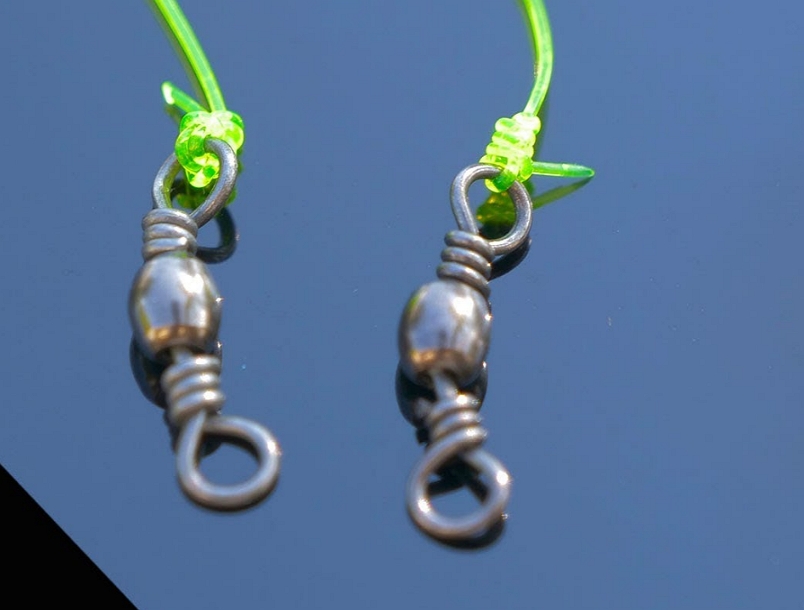A swivel is a device that attaches to the end of a fishing line and allows it to rotate freely. They are typically used when fighting large fish such as marlin, or when you need your bait to move in different directions like a jig head. This how-to guide will help you tie a swivel quickly and easily!
Steps on Tieing a Swivel
Step 1. Start with a large size loop at the end of your line. If you have a monofilament fishing line, pull it through the eye of the swivel and fold back on itself to create a knot that is similar to how you would tie an overhand knot.

Step 2. Connect another large size loop at least four inches away from the first loop.
Step 3. Tighten both loops by pulling on one side and then the other until they are relatively snug against each other, but not so tight that you cut off any of the lines inside.
Step 4. Use a lighter to melt one end of your fishing line (be careful!).
Step 5. Thread the end of your line through one of the loops.
Step 6. Wrap it around and thread it back through the loop, but don’t pull too tightly! Leave enough slack for you to tie a knot securely at that spot on your swivel.
Step 7. Pull both lines so they are tight against each other and then tie them together with a square knot.
Step 8. Trim the ends of your fishing line so they are about an inch long using scissors, or use a lighter to melt it off as you did before.
Your swivel is complete! Now just attach one end of your fishing line to any object that will stay still and one end to your fishing rod, and you are ready for some action!
Why Should we Tie a Swivel?
A swivel is a device that attaches to the end of your fishing line and rotates around on itself. It allows you to turn your rod without tangling up in it, which can be especially helpful for casting because instead of having to reel things in by hand, our rods do most of the work!
Benefits of Tieing a Swivel
- Eliminates tangles in fishing line
- Allows for long casts without backlashes that limit how far it can go.
- Improves the movement of your rod, allowing you to control how and where things are cast more easily.
How to Care for Swivel
The most important thing to remember about swivels is how not to lose them! It sounds silly, but they are so small and simple that it’s easy for them to fall off the fishing line.
The best way to prevent this from happening is by tying your lure or fly at least two feet above the water with a loop knot. This way if the swivel falls off, it will still be attached to your line and you can just reel it in.
Swivels don’t need any special care other than ensuring they are tied tightly enough to keep them on your fishing line for as long as possible! The best way to do this is with a loop knot like the one mentioned above.
One more thing to note is that swivels are not designed for use with braided fishing lines, so if you’re using a braided line it’s best to double-check the manufacturer’s recommendations before tying your hook onto the end your line and getting started.
What is the Best Knot to tie on a Swivel?
The best knot to tie on a swivel is the “loop” knot. This way, if the swivel falls off your line it will still be attached and you can just reel it in!
Swivels don’t need any special care beyond making sure they’re tied tightly enough to stay put for as long as possible. It’s always a good idea to use the loop knot when tying on your bait or lure so that you’ll be able to reel it back in if necessary!
How far Should Hook be From Swivel?
The hook should be at least one inch away from the swivel.
What is a Swivel?
A swivel is an eye, usually made of stainless steel or plastic that rotates 360 degrees and prevents line twists. It’s most often used when fishing with two lines to prevent tangles in both lines.
Swivels are usually made of stainless steel or plastic and work by preventing line twists when used with two lines. They rotate 360 degrees to allow for the most flexibility in how you set up your fishing rod!
The number one thing to look out for when buying a swivel is to make sure it’s rated for saltwater because, if it isn’t rated for saltwater, the swivel will corrode and break.
Swivels are used when fishing with two lines to prevent tangles in both lines! The most important thing to remember is that you need a stainless steel or plastic one; not only do they offer more flexibility than wire ones but they’re also less likely to cause any corrosion.
How do you tie a Heavy Braid to a Swivel?
Heavy braided line will be hard to tie on a swivel without the help of a crimping tool, which attaches lines to spools.
The best way is by tying an overhand knot with a heavy braid and attaching it to the eyelets of two swivels that are tied together with a light line. Once you attach these, you can then attach the braided line to one of them.
